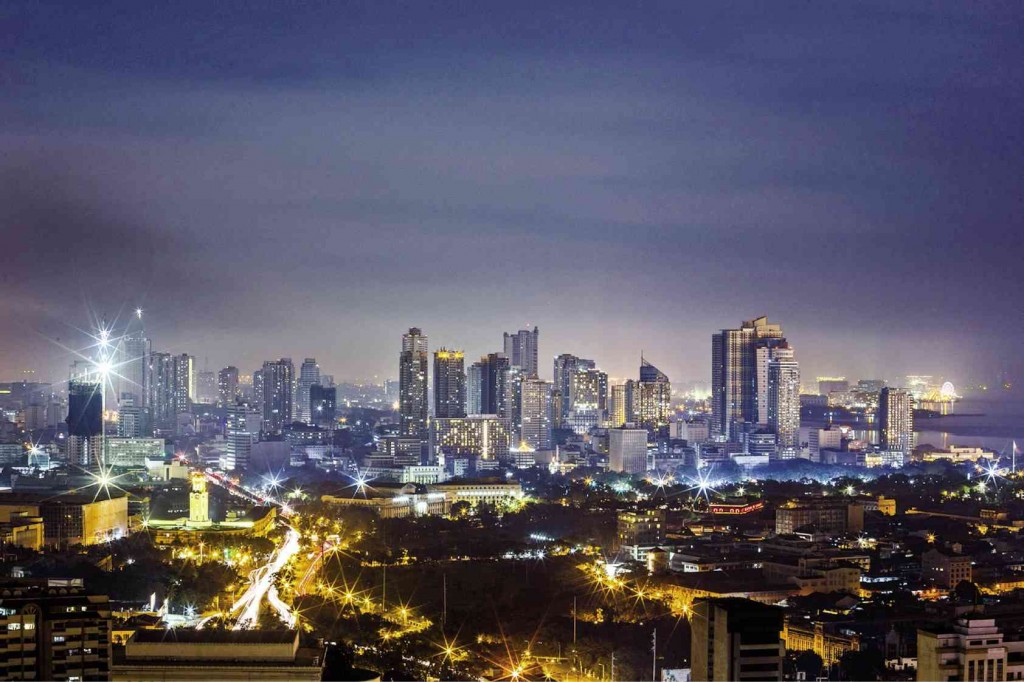
30TH BEST IN THE WORLD Metro Manila sparkles at night as befits its recent inclusion among the “Global Top 30,” an elite roster of the world’s most populous, productive and connected cities, according to the global property consulting firm Jones Lang Lasalle (JLL). The JLL cited Metro Manila’s economic scale, vast population, large gross domestic product and BPO specialization as its competitive edge. JILSON SECKLER TIU
The Philippine economy grew by 7.3 percent in the first quarter of the year, according to Moody’s Analytics.
Jumping the gun on the Philippine Statistics Authority (PSA), Moody’s Analytics confirmed the continued growth of the economy under the Aquino administration in a report posted on ABS-CBN’s online portal on Friday.
Moody’s Analytics, a think tank, is an affiliate of Moody’s Investors Service, one of the world’s three major credit rating agencies.
At press time, there was no immediate comment from Malacañang or the finance department, as the official report on the country’s first quarter gross domestic product (GDP) has yet to be released.
National Economic and Development Authority Director General Arsenio M. Balisacan and PSA National Statistician Lisa Grace S. Bersales will release the 2015 First Quarter Performance of the Philippine Economy on May 28.
Moody’s Analytics credited the strong performance of the economy in the first quarter of the year on government’s higher infrastructure investment and spending.
“Moody’s said strong electronics exports also gave the economy a lift due to improved global demand especially from the US. Likewise, the country is expected to benefit most from low oil prices with businesses and even consumers able to spend more due to savings from fuel costs,” said Moody’s Analytics, in a report posted on ABS-CBN’s online site.
Apec’s 3rd fastest growth in 2014
The report said a 7.3 percent growth would help the economy be on track to meet the Aquino administration’s full year target of 7 to 8 percent.
In 2014, the economy posted a full-year growth of 6.1 percent.
Also in 2014, the Philippines posted the third fastest GDP growth among the Asia-Pacific Economic Cooperation (Apec) economies, next to Papua New Guinea and China.
In Apec’s latest economic trends analysis titled, “Economic Resilience Amidst Global Headwinds,” the Philippines is seen growing by 6.7 percent this year, and 6.3 percent in 2016, enabling the country to remain as the third fastest growing economy among Apec members.
On the whole, the Apec members is seen to grow at a faster pace of 3.2 percent within the next two years on the back of a strong domestic demand and lower oil prices.
Silent
Citing data from the International Monetary Fund (IMF), the Apec said in its latest economic trends analysis that the economic growth in the near term would also hinge on the impact of the United States’ economic resurgence and normalization of the monetary policy.
Last year, Apec economies proved resilient amid challenging external conditions as the bloc posted an average growth of 2.9 percent, which was similar to the level in 2013, but lower compared to the 3.4 percent world GDP growth estimate by the IMF.
This was amid uncertainties surrounding the path of oil prices and the timing of monetary normalization in the US.
Upside opportunities
This year, upside opportunities for growth would come mainly from domestic factors, particularly robust household spending that is ably supported by steady government consumption and investment, according to economic trends analysis.
In turn, accommodative conditions marked by low interest rates and strong credit growth remain important determinants of private consumption expenditures.
Falling oil prices continue to generate positive impact for oil importers via the consumption channel by increasing households’ purchasing power, the report stated.
Downside risks meanwhile are largely external in nature.
Uncertainties
“Uncertainties surrounding the trajectory of oil prices and the timing of US monetary policy normalization combined with slower economic activity in China will impact on the near-term GDP growth of Apec economies. The steady and significant decline in oil prices is expected to directly affect oil exporters, weighing down output levels,” it said.
As economies rebalance towards domestic drivers of growth, Apec members will now need to strengthen private consumption through more inclusive and sustainable growth.
“This will require both increasing labor productivity and innovation to raise wages and living standards, as well as reducing income uncertainties through safety nets and social insurance to allow households to smooth consumption.
Fiscal consolidation programs
Economies could consider implementing fiscal consolidation programs, where appropriate, that will take into account spending rationalization, revenue generation and subsidy reforms, which will make public funds available for programs aimed at improving economic inclusiveness, sustainability and innovation,” the report stated.
Such programs, in turn, will need to cover skills development, investments in infrastructure (including regulatory and financial reforms), making labor markets more open for women and disadvantaged groups, and enhancing institutions and governance at all levels to strengthen transmission mechanisms between policy and inclusive growth.

